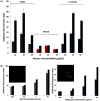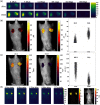Comparison of phosphorescent agents for noninvasive sensing of tumor oxygenation via Cherenkov-excited luminescence imaging
- PMID: 30834723
- PMCID: PMC6397946
- DOI: 10.1117/1.JBO.24.3.036001
Comparison of phosphorescent agents for noninvasive sensing of tumor oxygenation via Cherenkov-excited luminescence imaging
Abstract
Cherenkov emission generated in tissue during radiotherapy can be harnessed for the imaging biochemistry of tissue microenvironments. Cherenkov-excited luminescence scanned imaging (CELSI) provides a way to optically and noninvasively map oxygen-related signals, which is known to correlate to outcomes in radiotherapy. Four candidate phosphorescent reagents PtG4, MM2, Ir(btb)2 ( acac ) , and MitoID were studied for oxygen sensing, testing in a progressive series of (a) in solution, (b) in vitro, and (c) in subcutaneous tumors. In each test, the signal strength and response to oxygen were assessed by phosphorescence intensity and decay lifetime measurement. MM2 showed the most robust response to oxygen changes in solution, followed by PtG4, Ir(btb)2 ( acac ) , and MitoID. However, in PANC-1 cells, their oxygen responses differed with Ir(btb)2 ( acac ) exhibiting the largest phosphorescent intensity change in response to changes in oxygenation, followed by PtG4, MM2, and MitoID. In vivo, it was only possible to utilize Ir(btb)2 ( acac ) and PtG4, with each being used at nanomole levels, to determine signal strength, lifetime, and pO2. Oxygen sensing with CELSI during radiotherapy is feasible and can estimate values from 1 mm regions of tissue when used in the configuration of this study. PtG4 was the most amenable to in vivo sensing on the timescale of external beam LINAC x-rays.
Keywords: Cherenkov radiation; optical imaging; phosphorescence; tumor hypoxia.
Figures






Similar articles
-
Radiotherapy-induced Cherenkov luminescence imaging in a human body phantom.J Biomed Opt. 2018 Mar;23(3):1-4. doi: 10.1117/1.JBO.23.3.030504. J Biomed Opt. 2018. PMID: 29560623 Free PMC article.
-
Cherenkov excited phosphorescence-based pO2 estimation during multi-beam radiation therapy: phantom and simulation studies.Phys Med Biol. 2014 Sep 21;59(18):5317-5328. doi: 10.1088/0031-9155/59/18/5317. Epub 2014 Aug 22. Phys Med Biol. 2014. PMID: 25146556 Free PMC article.
-
Cherenkov-excited luminescence scanned imaging.Opt Lett. 2015 Mar 1;40(5):827-30. doi: 10.1364/OL.40.000827. Opt Lett. 2015. PMID: 25723443
-
Intracellular and in vivo oxygen sensing using phosphorescent iridium(III) complexes.Curr Opin Chem Biol. 2016 Aug;33:39-45. doi: 10.1016/j.cbpa.2016.05.017. Epub 2016 Jun 6. Curr Opin Chem Biol. 2016. PMID: 27281510 Review.
-
Review of in vivo optical molecular imaging and sensing from x-ray excitation.J Biomed Opt. 2021 Jan;26(1):010902. doi: 10.1117/1.JBO.26.1.010902. J Biomed Opt. 2021. PMID: 33386709 Free PMC article. Review.
Cited by
-
Shining New Light on Biological Systems: Luminescent Transition Metal Complexes for Bioimaging and Biosensing Applications.Chem Rev. 2024 Aug 14;124(15):8825-9014. doi: 10.1021/acs.chemrev.3c00629. Epub 2024 Jul 25. Chem Rev. 2024. PMID: 39052606 Free PMC article. Review.
-
Theoretical lateral and axial sensitivity limits and choices of molecular reporters for Cherenkov-excited luminescence in tissue during x-ray beam scanning.J Biomed Opt. 2020 Nov;25(11):116004. doi: 10.1117/1.JBO.25.11.116004. J Biomed Opt. 2020. PMID: 33185051 Free PMC article.
-
Two-Photon Phosphorescence Lifetime Microscopy.Adv Exp Med Biol. 2021;3233:63-82. doi: 10.1007/978-981-15-7627-0_4. Adv Exp Med Biol. 2021. PMID: 34053023
-
Cerenkov radiation-activated probes for deep cancer theranostics: a review.Theranostics. 2022 Oct 24;12(17):7404-7419. doi: 10.7150/thno.75279. eCollection 2022. Theranostics. 2022. PMID: 36438500 Free PMC article. Review.
-
Imaging luminescent tattoo inks for direct visualization of linac and cobalt irradiation.Med Phys. 2020 Apr;47(4):1807-1812. doi: 10.1002/mp.14094. Epub 2020 Mar 5. Med Phys. 2020. PMID: 32056218 Free PMC article.
References
Publication types
MeSH terms
Substances
Grants and funding
LinkOut - more resources
Full Text Sources
Other Literature Sources
Miscellaneous

